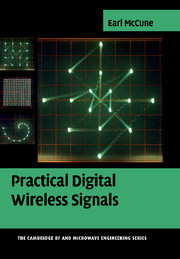Book contents
- Frontmatter
- Contents
- Preface
- Definitions and acronyms
- Terminology and notation
- 1 Keying, states, and block diagram construction
- 2 Common issues and signal characterization
- 3 Important details on results from Shannon, Nyquist, and others
- 4 Digital amplitude modulation (ASK)
- 5 Digital frequency modulation: FSK
- 6 Digital phase modulation: PSK
- 7 Combined digital modulations: QAM and OFDM
- 8 Spread spectrum
- 9 Wireless propagation and antenna fundamentals
- 10 Principles of coding
- 11 Multiple access techniques
- 12 Signal tradeoffs and system evolution
- Tutorial Appendices
- Index
- References
- Frontmatter
- Contents
- Preface
- Definitions and acronyms
- Terminology and notation
- 1 Keying, states, and block diagram construction
- 2 Common issues and signal characterization
- 3 Important details on results from Shannon, Nyquist, and others
- 4 Digital amplitude modulation (ASK)
- 5 Digital frequency modulation: FSK
- 6 Digital phase modulation: PSK
- 7 Combined digital modulations: QAM and OFDM
- 8 Spread spectrum
- 9 Wireless propagation and antenna fundamentals
- 10 Principles of coding
- 11 Multiple access techniques
- 12 Signal tradeoffs and system evolution
- Tutorial Appendices
- Index
- References
Summary
Spread spectrum is not really a modulation type, but is rather a communication system technique. Many different types of modulation can be, and have been, used in the implementation of spread spectrum systems. Of the various spread spectrum techniques that have been proposed and implemented over the years, there are two that survive to dominate the present implementations. These two are direct sequence spread spectrum (DSSS) and frequency hopping spread spectrum (FHSS).
One interpretation of any spread spectrum method is that the spreading process “breaks apart” the information signal into little pieces, using some type of code. A corresponding de-spreading process, using the same code, “knows” where these pieces are and reassembles them back together. In this reassembly process, any other signal (such as interference) will not match this reassembly process and therefore is effectively broken up into pieces of its own. Direct sequence and frequency hopping have different physical mechanisms for spreading and de-spreading, and have different properties in how they reject narrowband interference.
There are parallels among DSSS and FHSS systems which have led some authors to propose that these approaches are duals of each other. However there are some very distinct differences which show that these two approaches cannot be considered as duals of each other. Rather, each must be examined and evaluated on its individual merits. The proper choice of direct sequence or frequency hopping as a spread spectrum technique depends on the actual environment in which the system will be deployed.
- Type
- Chapter
- Information
- Practical Digital Wireless Signals , pp. 226 - 247Publisher: Cambridge University PressPrint publication year: 2010



